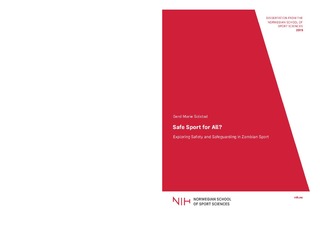| dc.contributor.author | Solstad, Gerd Marie | |
| dc.date.accessioned | 2019-03-08T12:08:40Z | |
| dc.date.available | 2019-03-08T12:08:40Z | |
| dc.date.issued | 2019 | |
| dc.identifier.isbn | 978-82-502-0568-0 | |
| dc.identifier.uri | http://hdl.handle.net/11250/2589364 | |
| dc.description | Avhandling (doktorgrad) - Norges idrettshøgskole, 2019 | nb_NO |
| dc.description.abstract | Safeguarding policies and regulations provide a way for sport associations to address abuse and promote “safe sport”. In recent years, formalized safeguarding in sport has gained ground within sport governance in many Western countries – and beyond. Moreover, safeguarding policies are sometimes integrated in transnational Sport for Development partnerships. This is the case for sport associations in Zambia working together with the Norwegian Olympic- and Paralympic Committee and Confederation of Sports (NIF).
The main ambition of this research project is to grasp possibilities and constraints associated with formalized safeguarding in Zambian sport associations in the context of their partnership with NIF. I explore the research question: “How are safety and safeguarding understood in the context of organized sport in Zambia?” The study draws empirically on fieldwork consisting of interviews with sport leaders, coaches and athletes in Zambian sport as well as participatory observation with two women’s sport teams. Research findings are presented in four articles that shed light on different aspects of the overall research question.
Article 1 focuses on understandings of safety in sport and in wider Zambian society. It shows that the interviewees in this study primarily portrayed sport as a safe arena for youth. Nevertheless, issues such as aggressive coaching methods, unhealthy athlete ideals and the potential for exploitation within asymmetrical power relations were addressed. Against this background, we drew attention to the potential conflict between a vision of safe sport and a sporting culture committed to an ethos of “faster, higher, stronger”.
Article 2 problematizes transactional sex as a safety concern for young women and looks into safeguarding resources drawn upon within sport-based social networks. Attention is drawn to the various forms of support offered by senior players to their younger teammates with the intention of steering them towards safe and sensible life choices. We argue that issues located in the grey area between sexual agency and sexual exploitation are important to consider in relation to safeguarding. Moreover, we show that safeguarding in sport can be perceived in ways that diverge from understandings found within organizational policy.
Article 3 examines how athletes perceive the prospect of formally reporting abuse in sport. The athletes described fears of punishment, disbelief, gossip and exclusion from sport, thus portraying reporting of abuse as demanding and risky. These findings alluded to athletes’ limited power over decisions affecting their sport participation and raised caution about relying too much on reporting procedures as a mechanism for detecting abuse in sport.
Article 4 considers motivations for addressing abuse through safeguarding by asking how safe sport is “culturally framed” within Zambian sport. The interviewed sport leaders expressed commitment to fighting abuse in sport and positioned safeguarding as an effective approach. They also portrayed safeguarding as consistent with several sport goals and in line with their moral commitments to athletes. The article proposes that political mobilization against abuse in Zambian sport was facilitated by a strong network of local mobilizing actors working for gender equality in and through sport.
Overall, this research draws attention to the vulnerabilities of athletes in resource-poor settings and shows that safety and safeguarding in sport can be understood in diverse ways. Due to local anchoring of the safe sport agenda, safeguarding may become embedded in Zambian sport. However, limited resources and competing problem areas within the sport associations are significant constraints. While the long-term impact of safeguarding remains to be seen, safe sport policies communicate an important message for sport associations to take action against abuse and to foreground the safety of athletes. | nb_NO |
| dc.description.abstract | Paper I: Solstad, G.M. and Strandbu, Å. (2017): Faster, Higher, Stronger… Safer? Safety concerns for young athletes in Zambia. International Review for the Sociology of Sport. DOI:10.1177/1012690217742926 | nb_NO |
| dc.description.abstract | Paper II: Solstad, G. M. and Rhind, D. (2018): Sport, Safeguarding and Transactional Sex: A Case Study of Social Networks in Zambian Sport. Sport in Society. DOI:10.1080/17430437.2018.1445990 | nb_NO |
| dc.description.abstract | Paper III: Solstad, G. M. (under review): Reporting Abuse in Sport: A Question of Power? European Journal for Sport and Society. | nb_NO |
| dc.description.abstract | Paper IV: Solstad, G.M. and Strandbu, Å. (submitted). Culturally Framing “Safe Sport”: On Political Mobilization against Abuse in Sport. International Journal of Sport Policy and Politics. | nb_NO |
| dc.language.iso | eng | nb_NO |
| dc.subject | nih | nb_NO |
| dc.subject | doktoravhandlinger | nb_NO |
| dc.title | Safe sport for all?: Exploring safety and safeguarding in Zambian sport | nb_NO |
| dc.type | Doctoral thesis | nb_NO |
| dc.description.localcode | Seksjon for kultur og samfunn / Department of Cultural and Social Studies | nb_NO |
